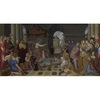-
Home
-
Contributors
-
International
-
Account
-
Information
More From Contributor
- 1374). Love's arrows ...
- a group of flamboyantly dressed musicians seen by candlelight
- & treated it in his own distinctive manner, placing the dramatically lit half-length figures against a light background. Paintings of the same subject by Caravaggio (New York, Metropolitan Museum of Art) & Bartolommeo Manfredi (Florence, Uffizi) are among the prototypes for this composition. Their large-scale, half-length figures, their crowding together within the composition & their closeness to the edge of the canvas, as well as the bright, colourful palette can all be found in this painting. Ter Brugghen brings to this existing format an individual fluency in modelling the soft edges of his forms & a remarkable subtlety of palette. ...
- or subsequent consecration
- with an angel above bringing his bishop's stole, crozier & mitre. The saint humbly obeys. In 1087 Saint Nicholas's remains were translated to Bari. This work was painted for the altar of Saint Nicholas in S. Benedetto Po, near Mantua, where it was probably installed in 1562. ...
The Continence Of Scipio
- Availability: In Stock
- Supplier: National Gallery
- SKU: NG643-dot-2
Product Description
These four pictures are from a series illustrating stories from ancient Roman history. They show (top to bottom): ' The Attack on Cartagena', ' The Continence of Scipio', ' The Rape of the Sabines' & ' The Intervention of the Sabine Women'. Two other pictures from the same series are known: a ' Coriolanus' & a ' Scipio rewarding the Soldiers'. ' The Continence of Scipio' & ' Rape of the Sabines' were popular topics for illustration. The format of the pictures suggests they were made for the decoration of a room. The series is now thought to be the work of a minor Italian painter of the third quarter of the 16th century who was familiar with the work of Giulio Romano & Raphael, on whose styles they depend.
Reviews/Comments
Add New
Intelligent Comparison
We couldn't find anything!
Perhaps this product's unique.... Or perhaps we are still looking for comparisons!
Click to bump this page and we'll hurry up.
Price History
Vouchers
Do you know a voucher code for this product or supplier? Add it to Insights for others to use.


 United Kingdom
United Kingdom
 France
France
 Germany
Germany
 Netherlands
Netherlands
 Sweden
Sweden
 USA
USA
 Italy
Italy
 Spain
Spain









 Denmark
Denmark